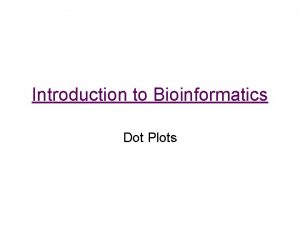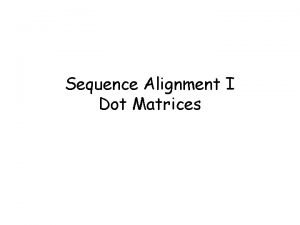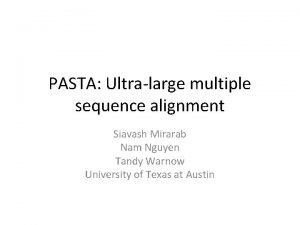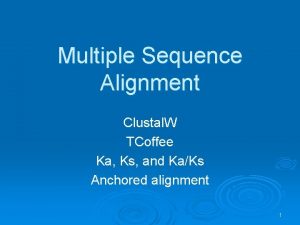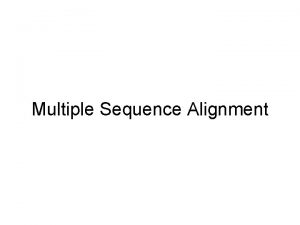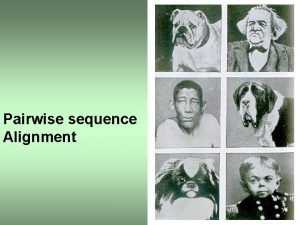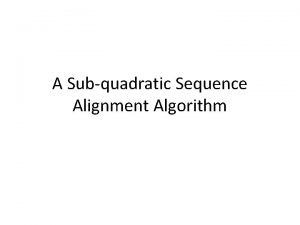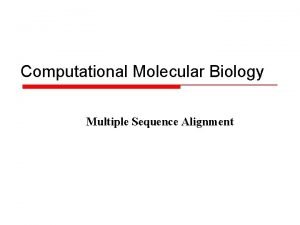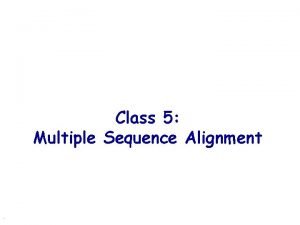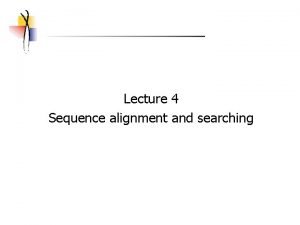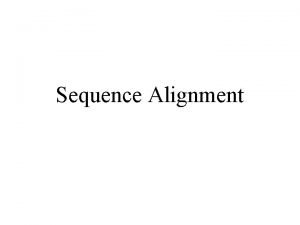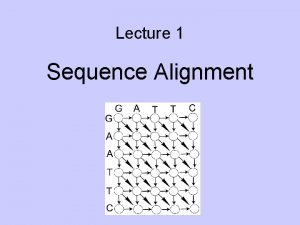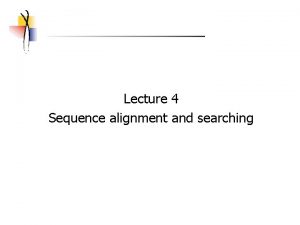Sequence Alignment I Dot Matrices Reading Mount Chapters















- Slides: 15

Sequence Alignment I Dot Matrices

Reading • Mount, Chapters 1, 2, and 3 (up to page 94) 2

Why compare sequences? • To find whether two (or more) genes or proteins are evolutionarily related to each other • To find structurally or functionally similar regions within proteins 3

Similar genes arise by gene duplication • Copy of a gene inserted next to the original • Two copies mutate independently • Each can take on separate functions • All or part can be transferred from one part of genome to another 4

Sequence Comparison Methods • Dot matrix analysis • Dynamic Programming • Word or k-tuple methods (FASTA and BLAST) 5

Dot matrices a c g 6

Dot matrix comparison 7

Interpretation • Regions of similarity appear as diagonal runs of dots • Reverse diagonals (perpendicular to diagonal) indicate inversions • Reverse diagonals crossing diagonals (Xs) indicate palindromes 8

Interpretation • Can link separate diagonals to form alignment with gaps – Each a. a. or base can only be used once • Can't double back – A gap is introduced by each vertical or horizontal skip 9

Filtering • Dot matrices for long sequences can be noisy due to insignificant matches • Solution: use a window and a threshold – compare character by character within a window (have to choose window size) – require certain fraction of matches within window in order to display it with a dot 10

Dot plot comparison using windows Window size = 11 Stringency = 7 (Put a dot only if 7 out of next 11 positions are identical. ) 11

Uses for dot matrices • Aligning two proteins or two nucleic acid sequences • Finding amino acid repeats within a protein by comparing a protein sequence to itself – Repeats appear as a set of diagonal runs stacked vertically and/or horizontally 12

Repeats Human LDL receptor protein sequence (Genbank P 01130) W=1 S=1 (Mount, Fig. 3. 6) 13

Repeats W = 23 S=7 (Mount, Fig. 3. 6) 14

Using substitution matrices • Dots can have weights • Some matches are rewarded more than others, depending on likelihood – Use PAM or BLOSUM matrix (more on these later) • Put a dot only if a minimum total or average weight is achieved – See Mount, Fig. 3. 5 15
 Dot plot sequence alignment
Dot plot sequence alignment 192 dot 168 dot 1 dot 1
192 dot 168 dot 1 dot 1 Global alignment example
Global alignment example Dna substitution
Dna substitution Global alignment vs local alignment
Global alignment vs local alignment Global alignment
Global alignment Global vs local alignment
Global vs local alignment Dot matrix alignment
Dot matrix alignment Pre reading while reading and post reading activities
Pre reading while reading and post reading activities T coffee multiple sequence alignment
T coffee multiple sequence alignment Pasta alignment
Pasta alignment Bioedit sequence alignment editor download
Bioedit sequence alignment editor download Emboss clustal omega
Emboss clustal omega Kkllkk profile
Kkllkk profile Ebi simple phylogeny
Ebi simple phylogeny A named sequence of statements is known as
A named sequence of statements is known as
